Exercise Physiology and Touch Football
VerifiedAdded on 2023/06/07
|12
|1891
|335
AI Summary
This report discusses the energy systems used in touch football, fitness components specific to touch football, and appropriate fitness tests for each component. It also includes graphical representations of fitness test data and implications of fitness testing on performance in touch football.
Contribute Materials
Your contribution can guide someone’s learning journey. Share your
documents today.
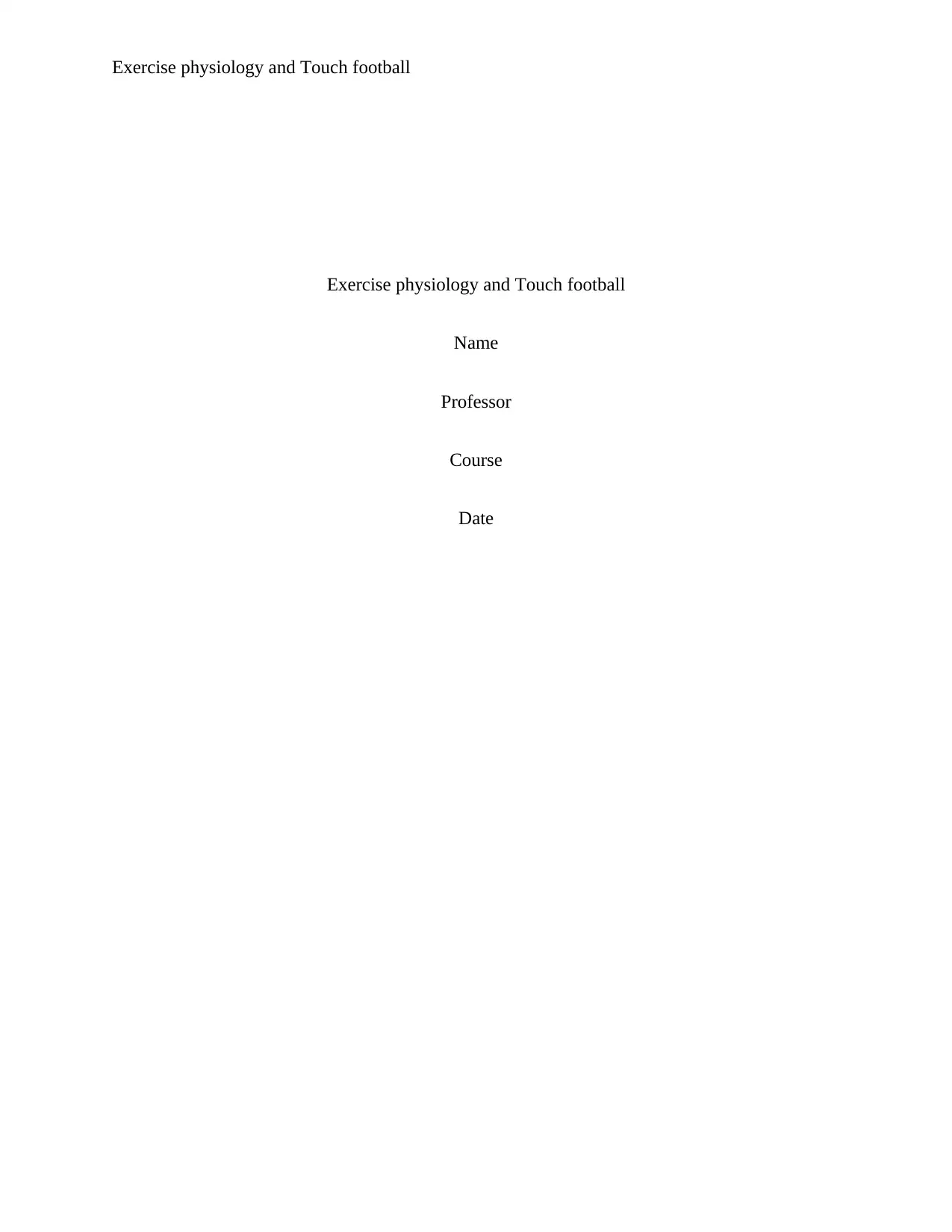
Exercise physiology and Touch football
Exercise physiology and Touch football
Name
Professor
Course
Date
Exercise physiology and Touch football
Name
Professor
Course
Date
Secure Best Marks with AI Grader
Need help grading? Try our AI Grader for instant feedback on your assignments.
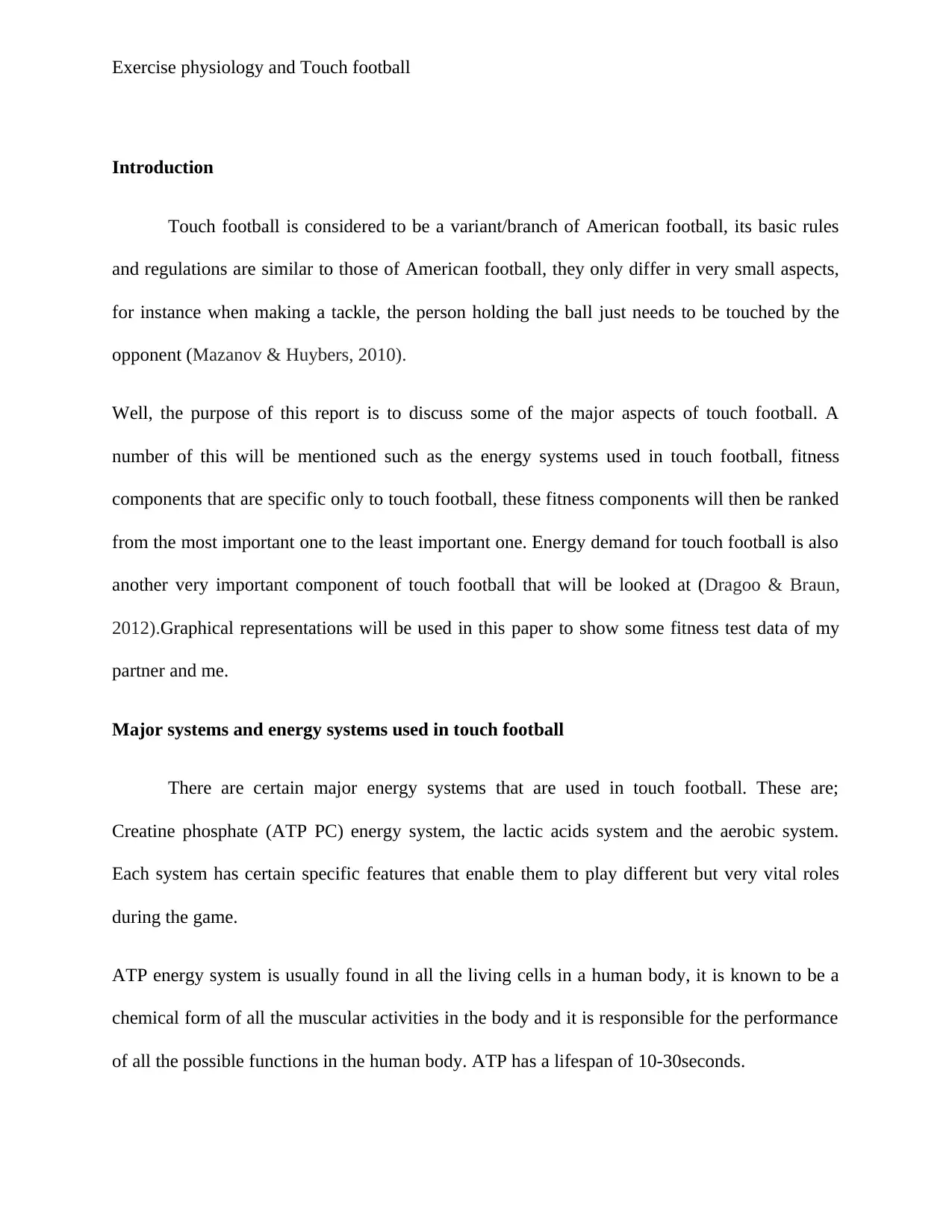
Exercise physiology and Touch football
Introduction
Touch football is considered to be a variant/branch of American football, its basic rules
and regulations are similar to those of American football, they only differ in very small aspects,
for instance when making a tackle, the person holding the ball just needs to be touched by the
opponent (Mazanov & Huybers, 2010).
Well, the purpose of this report is to discuss some of the major aspects of touch football. A
number of this will be mentioned such as the energy systems used in touch football, fitness
components that are specific only to touch football, these fitness components will then be ranked
from the most important one to the least important one. Energy demand for touch football is also
another very important component of touch football that will be looked at (Dragoo & Braun,
2012).Graphical representations will be used in this paper to show some fitness test data of my
partner and me.
Major systems and energy systems used in touch football
There are certain major energy systems that are used in touch football. These are;
Creatine phosphate (ATP PC) energy system, the lactic acids system and the aerobic system.
Each system has certain specific features that enable them to play different but very vital roles
during the game.
ATP energy system is usually found in all the living cells in a human body, it is known to be a
chemical form of all the muscular activities in the body and it is responsible for the performance
of all the possible functions in the human body. ATP has a lifespan of 10-30seconds.
Introduction
Touch football is considered to be a variant/branch of American football, its basic rules
and regulations are similar to those of American football, they only differ in very small aspects,
for instance when making a tackle, the person holding the ball just needs to be touched by the
opponent (Mazanov & Huybers, 2010).
Well, the purpose of this report is to discuss some of the major aspects of touch football. A
number of this will be mentioned such as the energy systems used in touch football, fitness
components that are specific only to touch football, these fitness components will then be ranked
from the most important one to the least important one. Energy demand for touch football is also
another very important component of touch football that will be looked at (Dragoo & Braun,
2012).Graphical representations will be used in this paper to show some fitness test data of my
partner and me.
Major systems and energy systems used in touch football
There are certain major energy systems that are used in touch football. These are;
Creatine phosphate (ATP PC) energy system, the lactic acids system and the aerobic system.
Each system has certain specific features that enable them to play different but very vital roles
during the game.
ATP energy system is usually found in all the living cells in a human body, it is known to be a
chemical form of all the muscular activities in the body and it is responsible for the performance
of all the possible functions in the human body. ATP has a lifespan of 10-30seconds.
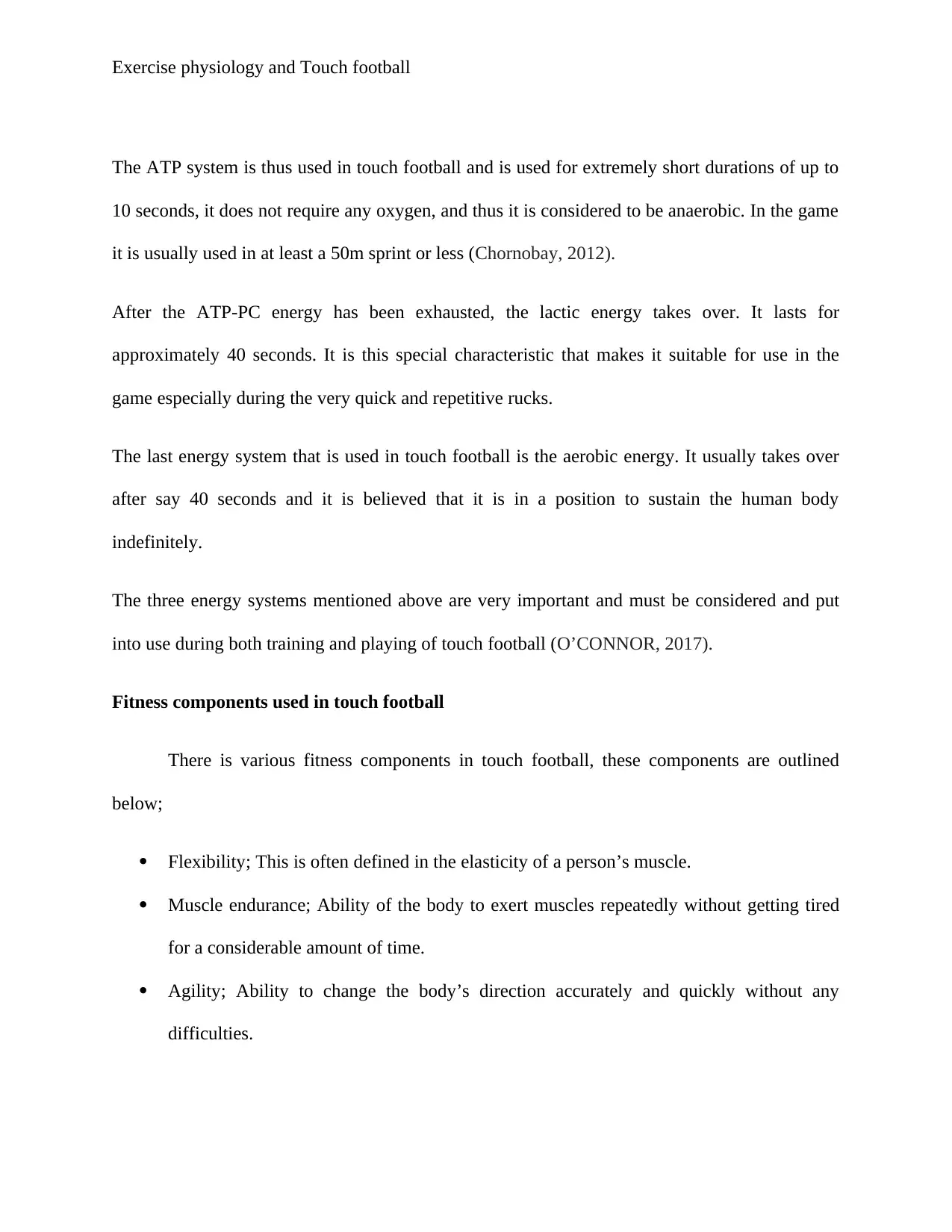
Exercise physiology and Touch football
The ATP system is thus used in touch football and is used for extremely short durations of up to
10 seconds, it does not require any oxygen, and thus it is considered to be anaerobic. In the game
it is usually used in at least a 50m sprint or less (Chornobay, 2012).
After the ATP-PC energy has been exhausted, the lactic energy takes over. It lasts for
approximately 40 seconds. It is this special characteristic that makes it suitable for use in the
game especially during the very quick and repetitive rucks.
The last energy system that is used in touch football is the aerobic energy. It usually takes over
after say 40 seconds and it is believed that it is in a position to sustain the human body
indefinitely.
The three energy systems mentioned above are very important and must be considered and put
into use during both training and playing of touch football (O’CONNOR, 2017).
Fitness components used in touch football
There is various fitness components in touch football, these components are outlined
below;
Flexibility; This is often defined in the elasticity of a person’s muscle.
Muscle endurance; Ability of the body to exert muscles repeatedly without getting tired
for a considerable amount of time.
Agility; Ability to change the body’s direction accurately and quickly without any
difficulties.
The ATP system is thus used in touch football and is used for extremely short durations of up to
10 seconds, it does not require any oxygen, and thus it is considered to be anaerobic. In the game
it is usually used in at least a 50m sprint or less (Chornobay, 2012).
After the ATP-PC energy has been exhausted, the lactic energy takes over. It lasts for
approximately 40 seconds. It is this special characteristic that makes it suitable for use in the
game especially during the very quick and repetitive rucks.
The last energy system that is used in touch football is the aerobic energy. It usually takes over
after say 40 seconds and it is believed that it is in a position to sustain the human body
indefinitely.
The three energy systems mentioned above are very important and must be considered and put
into use during both training and playing of touch football (O’CONNOR, 2017).
Fitness components used in touch football
There is various fitness components in touch football, these components are outlined
below;
Flexibility; This is often defined in the elasticity of a person’s muscle.
Muscle endurance; Ability of the body to exert muscles repeatedly without getting tired
for a considerable amount of time.
Agility; Ability to change the body’s direction accurately and quickly without any
difficulties.
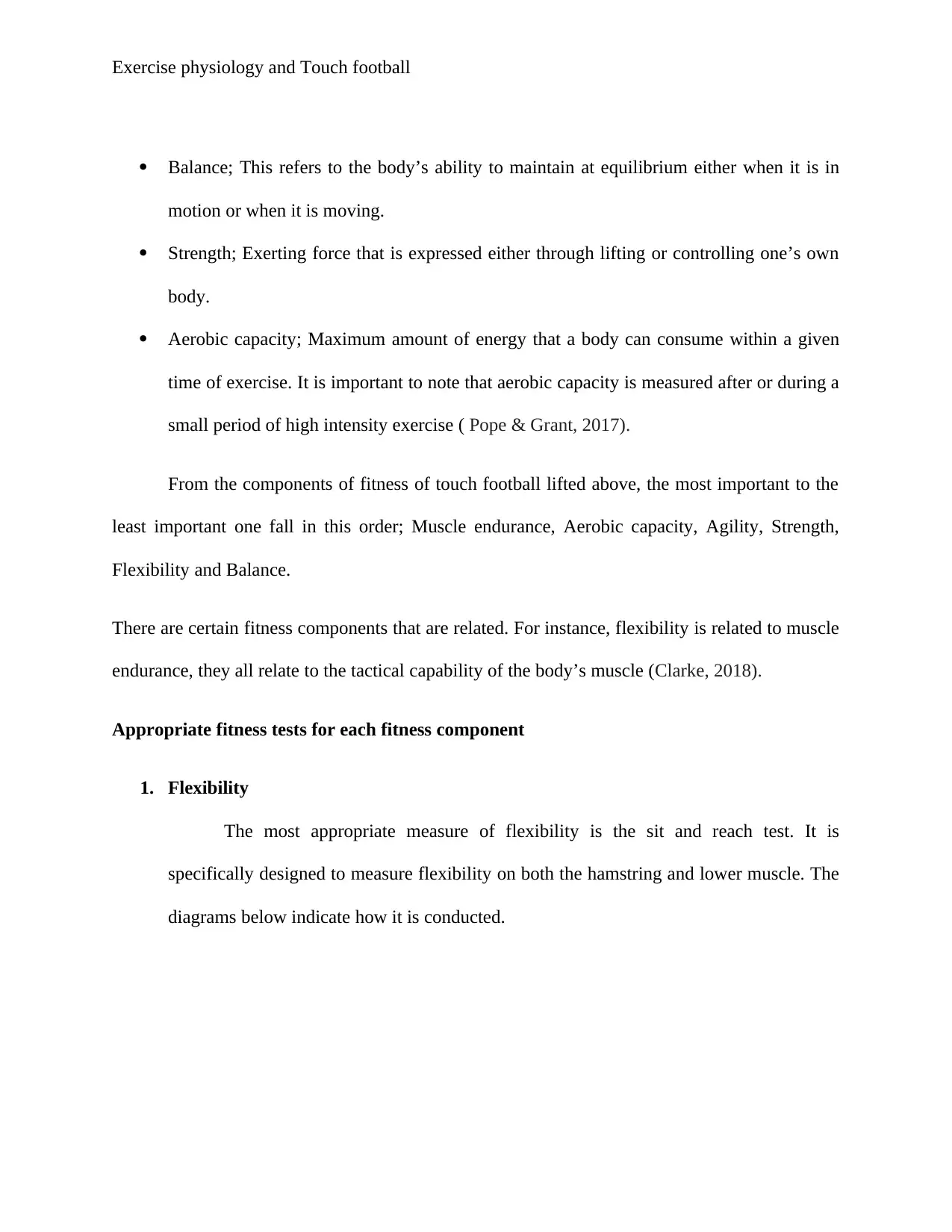
Exercise physiology and Touch football
Balance; This refers to the body’s ability to maintain at equilibrium either when it is in
motion or when it is moving.
Strength; Exerting force that is expressed either through lifting or controlling one’s own
body.
Aerobic capacity; Maximum amount of energy that a body can consume within a given
time of exercise. It is important to note that aerobic capacity is measured after or during a
small period of high intensity exercise ( Pope & Grant, 2017).
From the components of fitness of touch football lifted above, the most important to the
least important one fall in this order; Muscle endurance, Aerobic capacity, Agility, Strength,
Flexibility and Balance.
There are certain fitness components that are related. For instance, flexibility is related to muscle
endurance, they all relate to the tactical capability of the body’s muscle (Clarke, 2018).
Appropriate fitness tests for each fitness component
1. Flexibility
The most appropriate measure of flexibility is the sit and reach test. It is
specifically designed to measure flexibility on both the hamstring and lower muscle. The
diagrams below indicate how it is conducted.
Balance; This refers to the body’s ability to maintain at equilibrium either when it is in
motion or when it is moving.
Strength; Exerting force that is expressed either through lifting or controlling one’s own
body.
Aerobic capacity; Maximum amount of energy that a body can consume within a given
time of exercise. It is important to note that aerobic capacity is measured after or during a
small period of high intensity exercise ( Pope & Grant, 2017).
From the components of fitness of touch football lifted above, the most important to the
least important one fall in this order; Muscle endurance, Aerobic capacity, Agility, Strength,
Flexibility and Balance.
There are certain fitness components that are related. For instance, flexibility is related to muscle
endurance, they all relate to the tactical capability of the body’s muscle (Clarke, 2018).
Appropriate fitness tests for each fitness component
1. Flexibility
The most appropriate measure of flexibility is the sit and reach test. It is
specifically designed to measure flexibility on both the hamstring and lower muscle. The
diagrams below indicate how it is conducted.
Paraphrase This Document
Need a fresh take? Get an instant paraphrase of this document with our AI Paraphraser
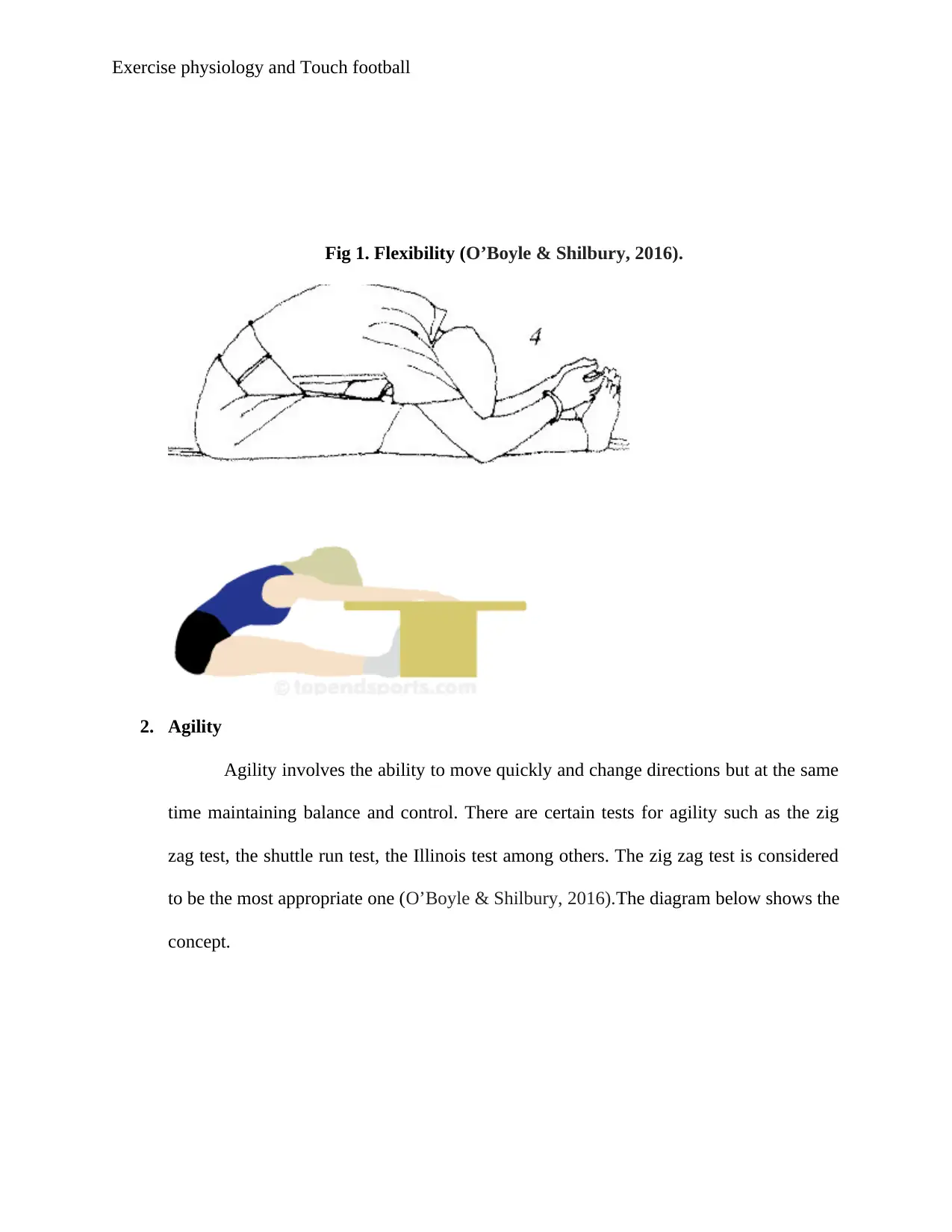
Exercise physiology and Touch football
Fig 1. Flexibility (O’Boyle & Shilbury, 2016).
2. Agility
Agility involves the ability to move quickly and change directions but at the same
time maintaining balance and control. There are certain tests for agility such as the zig
zag test, the shuttle run test, the Illinois test among others. The zig zag test is considered
to be the most appropriate one (O’Boyle & Shilbury, 2016).The diagram below shows the
concept.
Fig 1. Flexibility (O’Boyle & Shilbury, 2016).
2. Agility
Agility involves the ability to move quickly and change directions but at the same
time maintaining balance and control. There are certain tests for agility such as the zig
zag test, the shuttle run test, the Illinois test among others. The zig zag test is considered
to be the most appropriate one (O’Boyle & Shilbury, 2016).The diagram below shows the
concept.
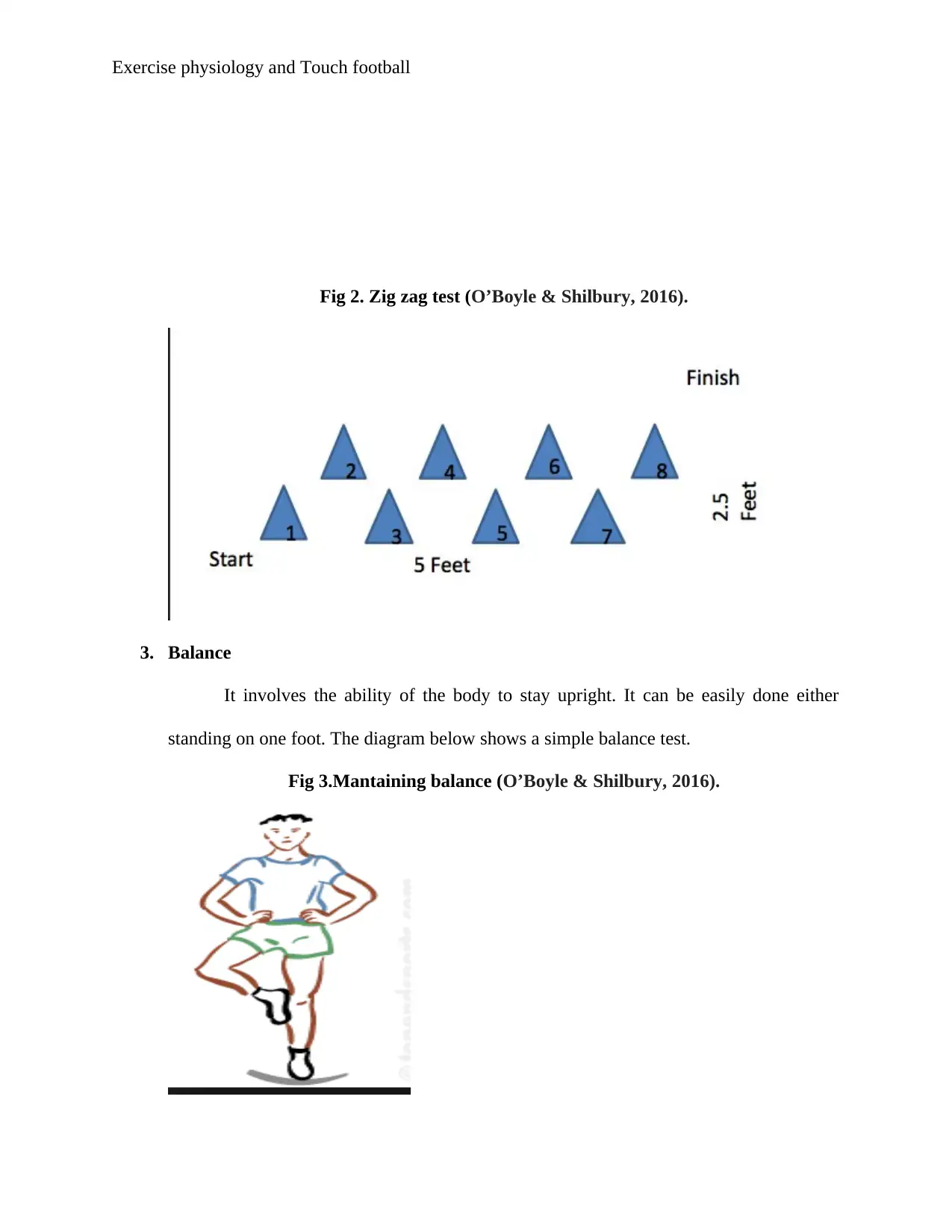
Exercise physiology and Touch football
Fig 2. Zig zag test (O’Boyle & Shilbury, 2016).
3. Balance
It involves the ability of the body to stay upright. It can be easily done either
standing on one foot. The diagram below shows a simple balance test.
Fig 3.Mantaining balance (O’Boyle & Shilbury, 2016).
Fig 2. Zig zag test (O’Boyle & Shilbury, 2016).
3. Balance
It involves the ability of the body to stay upright. It can be easily done either
standing on one foot. The diagram below shows a simple balance test.
Fig 3.Mantaining balance (O’Boyle & Shilbury, 2016).
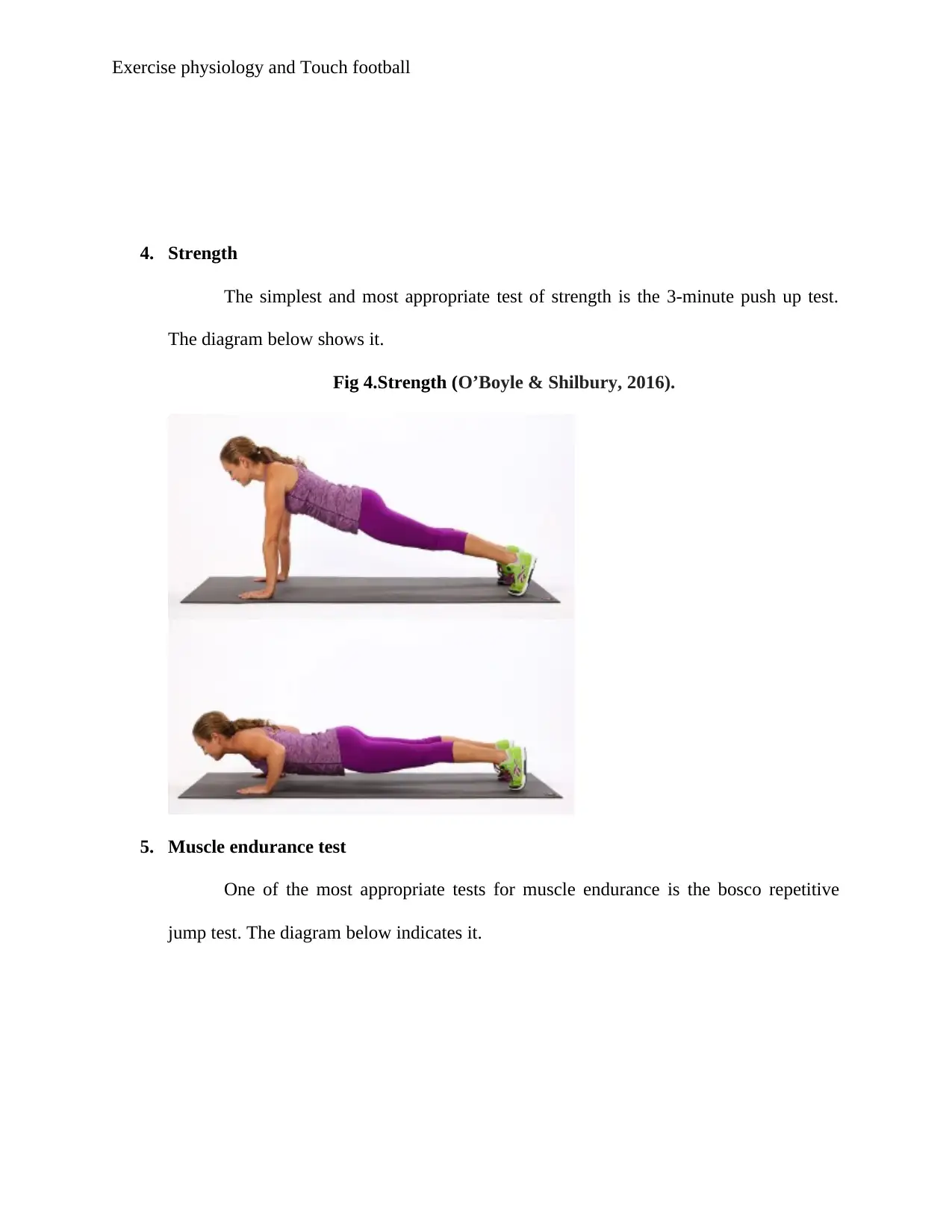
Exercise physiology and Touch football
4. Strength
The simplest and most appropriate test of strength is the 3-minute push up test.
The diagram below shows it.
Fig 4.Strength (O’Boyle & Shilbury, 2016).
5. Muscle endurance test
One of the most appropriate tests for muscle endurance is the bosco repetitive
jump test. The diagram below indicates it.
4. Strength
The simplest and most appropriate test of strength is the 3-minute push up test.
The diagram below shows it.
Fig 4.Strength (O’Boyle & Shilbury, 2016).
5. Muscle endurance test
One of the most appropriate tests for muscle endurance is the bosco repetitive
jump test. The diagram below indicates it.
Secure Best Marks with AI Grader
Need help grading? Try our AI Grader for instant feedback on your assignments.

Exercise physiology and Touch football
Fig 5.Muscle endurance test (O’Boyle & Shilbury, 2016).
6. Aerobic capacity
The multistage fitness test is considered to be the most appropriate aerobic tests of
all time. It is shown in the diagram below.
Fig 6.Aerobic capacity (Kennedy, 2012).
Implementation of the fitness tests on me and my partner
After an implementation of the above mentioned fitness tests on my partner and I, the
following results were obtained as plotted in the graphs below;
Fig 5.Muscle endurance test (O’Boyle & Shilbury, 2016).
6. Aerobic capacity
The multistage fitness test is considered to be the most appropriate aerobic tests of
all time. It is shown in the diagram below.
Fig 6.Aerobic capacity (Kennedy, 2012).
Implementation of the fitness tests on me and my partner
After an implementation of the above mentioned fitness tests on my partner and I, the
following results were obtained as plotted in the graphs below;
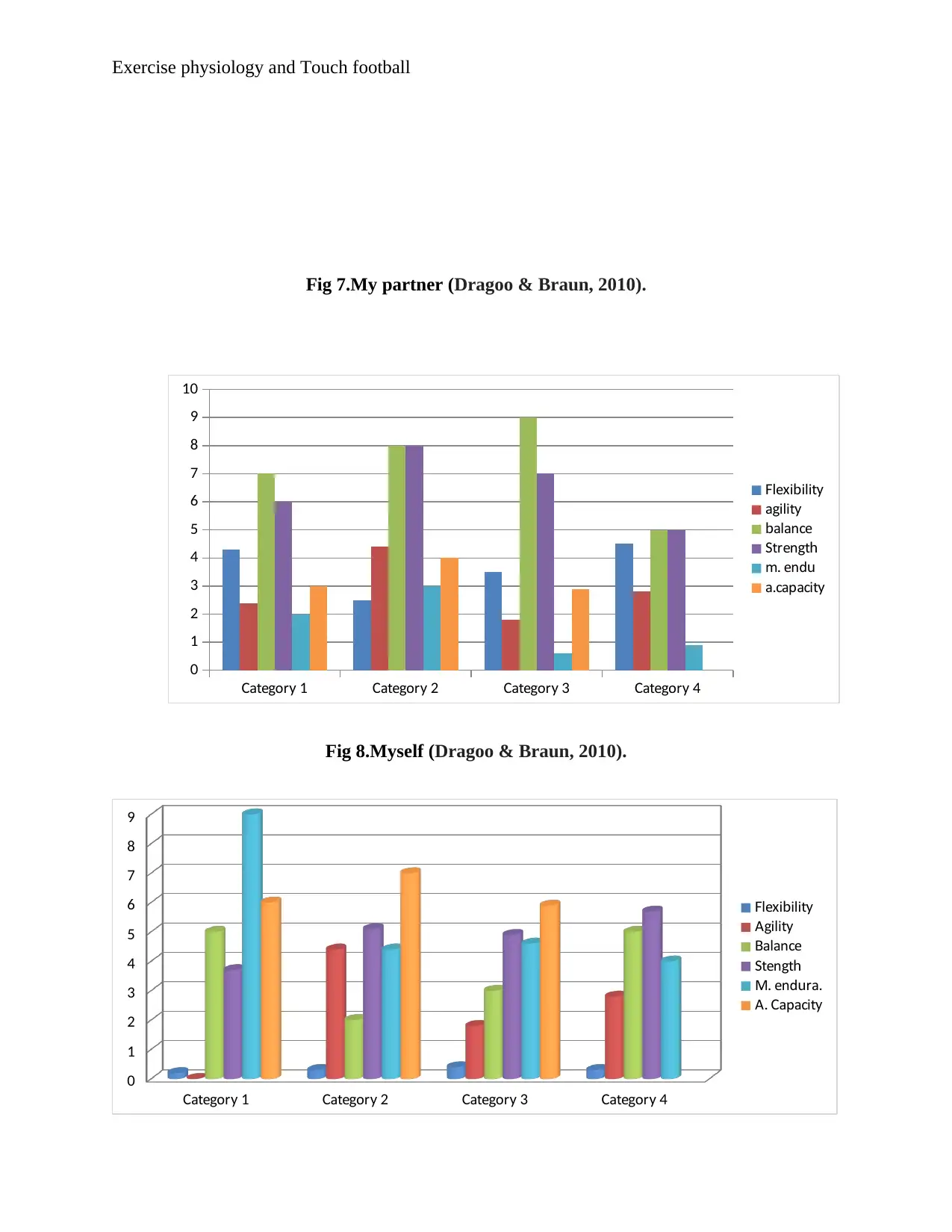
Exercise physiology and Touch football
Fig 7.My partner (Dragoo & Braun, 2010).
ate orC g y 1 ate orC g y 2 ate orC g y 3 ate orC g y 4
0
1
2
3
4
5
6
7
8
9
10
le i ilitF x b y
a ilitg y
alanceb
tren tS g h
m end. u
a capacit. y
Fig 8.Myself (Dragoo & Braun, 2010).
ate orC g y 1 ate orC g y 2 ate orC g y 3 ate orC g y 4
0
1
2
3
4
5
6
7
8
9
le i ilitF x b y
A ilitg y
alanceB
ten tS g h
M end ra. u .
A apacit. C y
Fig 7.My partner (Dragoo & Braun, 2010).
ate orC g y 1 ate orC g y 2 ate orC g y 3 ate orC g y 4
0
1
2
3
4
5
6
7
8
9
10
le i ilitF x b y
a ilitg y
alanceb
tren tS g h
m end. u
a capacit. y
Fig 8.Myself (Dragoo & Braun, 2010).
ate orC g y 1 ate orC g y 2 ate orC g y 3 ate orC g y 4
0
1
2
3
4
5
6
7
8
9
le i ilitF x b y
A ilitg y
alanceB
ten tS g h
M end ra. u .
A apacit. C y

Exercise physiology and Touch football
From the graphs above, I can make a really good middle because I am aerobically fit.
My partner can make a very good link because of his high acceleration ability.
It is very clear that I cannot make a good wing. I am not fast enough and my anticipation ability
is not so good. My partner can try the wing position but it will definitely not fit so well for him
due to the fact that he is not a reliable ball catcher.
Implications of fitness testing on performance in touch football
Testing fitness in touch football is very important. It is meant to determine the best
position that one can fit in. Performance and fitness test in touch football are directly related.
When fitness is not tested for, then we might end up putting the wrong persons in the wrong
positions and this will negatively affect our performance (Dragoo & Braun, 2010).
Limitations of testing procedures
Testing procedure can at times be a challenge. For instance, different players come to the
ground each day having different levels of morale and attitude. So determining the actual
potential on one player based on the fitness testing becomes a challenge as the human body is
made in such a way that it responds differently depending on the surrounding and also the
mechanism.
Recommendations on improving each profile
My profile-From my profile, it can be seen that I have a weakness in flexibility and
strength. This can be improved by me thoroughly working on both my flexibility and strength.\
From the graphs above, I can make a really good middle because I am aerobically fit.
My partner can make a very good link because of his high acceleration ability.
It is very clear that I cannot make a good wing. I am not fast enough and my anticipation ability
is not so good. My partner can try the wing position but it will definitely not fit so well for him
due to the fact that he is not a reliable ball catcher.
Implications of fitness testing on performance in touch football
Testing fitness in touch football is very important. It is meant to determine the best
position that one can fit in. Performance and fitness test in touch football are directly related.
When fitness is not tested for, then we might end up putting the wrong persons in the wrong
positions and this will negatively affect our performance (Dragoo & Braun, 2010).
Limitations of testing procedures
Testing procedure can at times be a challenge. For instance, different players come to the
ground each day having different levels of morale and attitude. So determining the actual
potential on one player based on the fitness testing becomes a challenge as the human body is
made in such a way that it responds differently depending on the surrounding and also the
mechanism.
Recommendations on improving each profile
My profile-From my profile, it can be seen that I have a weakness in flexibility and
strength. This can be improved by me thoroughly working on both my flexibility and strength.\
Paraphrase This Document
Need a fresh take? Get an instant paraphrase of this document with our AI Paraphraser
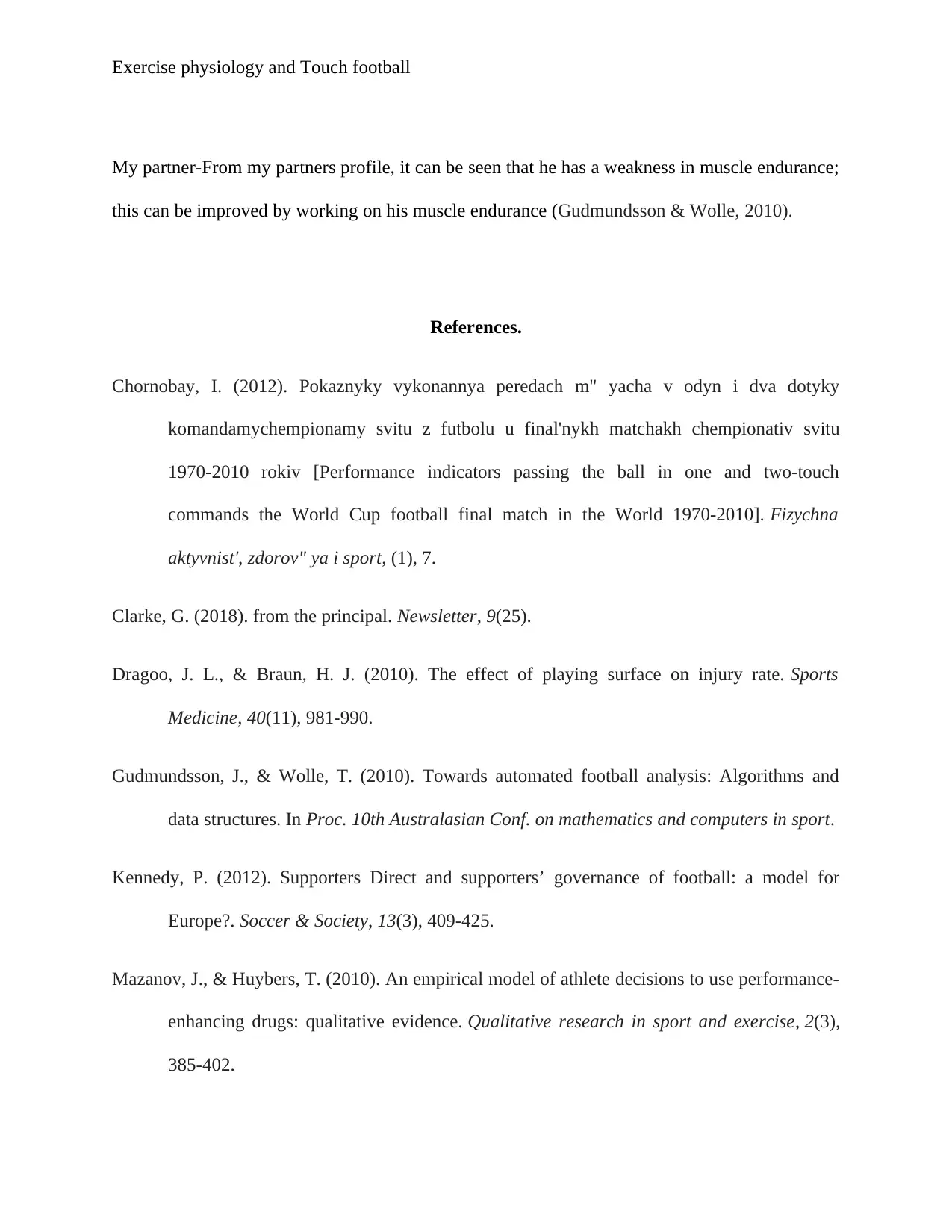
Exercise physiology and Touch football
My partner-From my partners profile, it can be seen that he has a weakness in muscle endurance;
this can be improved by working on his muscle endurance (Gudmundsson & Wolle, 2010).
References.
Chornobay, I. (2012). Pokaznyky vykonannya peredach m" yacha v odyn i dva dotyky
komandamychempionamy svitu z futbolu u final'nykh matchakh chempionativ svitu
1970-2010 rokiv [Performance indicators passing the ball in one and two-touch
commands the World Cup football final match in the World 1970-2010]. Fizychna
aktyvnist', zdorov" ya i sport, (1), 7.
Clarke, G. (2018). from the principal. Newsletter, 9(25).
Dragoo, J. L., & Braun, H. J. (2010). The effect of playing surface on injury rate. Sports
Medicine, 40(11), 981-990.
Gudmundsson, J., & Wolle, T. (2010). Towards automated football analysis: Algorithms and
data structures. In Proc. 10th Australasian Conf. on mathematics and computers in sport.
Kennedy, P. (2012). Supporters Direct and supporters’ governance of football: a model for
Europe?. Soccer & Society, 13(3), 409-425.
Mazanov, J., & Huybers, T. (2010). An empirical model of athlete decisions to use performance‐
enhancing drugs: qualitative evidence. Qualitative research in sport and exercise, 2(3),
385-402.
My partner-From my partners profile, it can be seen that he has a weakness in muscle endurance;
this can be improved by working on his muscle endurance (Gudmundsson & Wolle, 2010).
References.
Chornobay, I. (2012). Pokaznyky vykonannya peredach m" yacha v odyn i dva dotyky
komandamychempionamy svitu z futbolu u final'nykh matchakh chempionativ svitu
1970-2010 rokiv [Performance indicators passing the ball in one and two-touch
commands the World Cup football final match in the World 1970-2010]. Fizychna
aktyvnist', zdorov" ya i sport, (1), 7.
Clarke, G. (2018). from the principal. Newsletter, 9(25).
Dragoo, J. L., & Braun, H. J. (2010). The effect of playing surface on injury rate. Sports
Medicine, 40(11), 981-990.
Gudmundsson, J., & Wolle, T. (2010). Towards automated football analysis: Algorithms and
data structures. In Proc. 10th Australasian Conf. on mathematics and computers in sport.
Kennedy, P. (2012). Supporters Direct and supporters’ governance of football: a model for
Europe?. Soccer & Society, 13(3), 409-425.
Mazanov, J., & Huybers, T. (2010). An empirical model of athlete decisions to use performance‐
enhancing drugs: qualitative evidence. Qualitative research in sport and exercise, 2(3),
385-402.
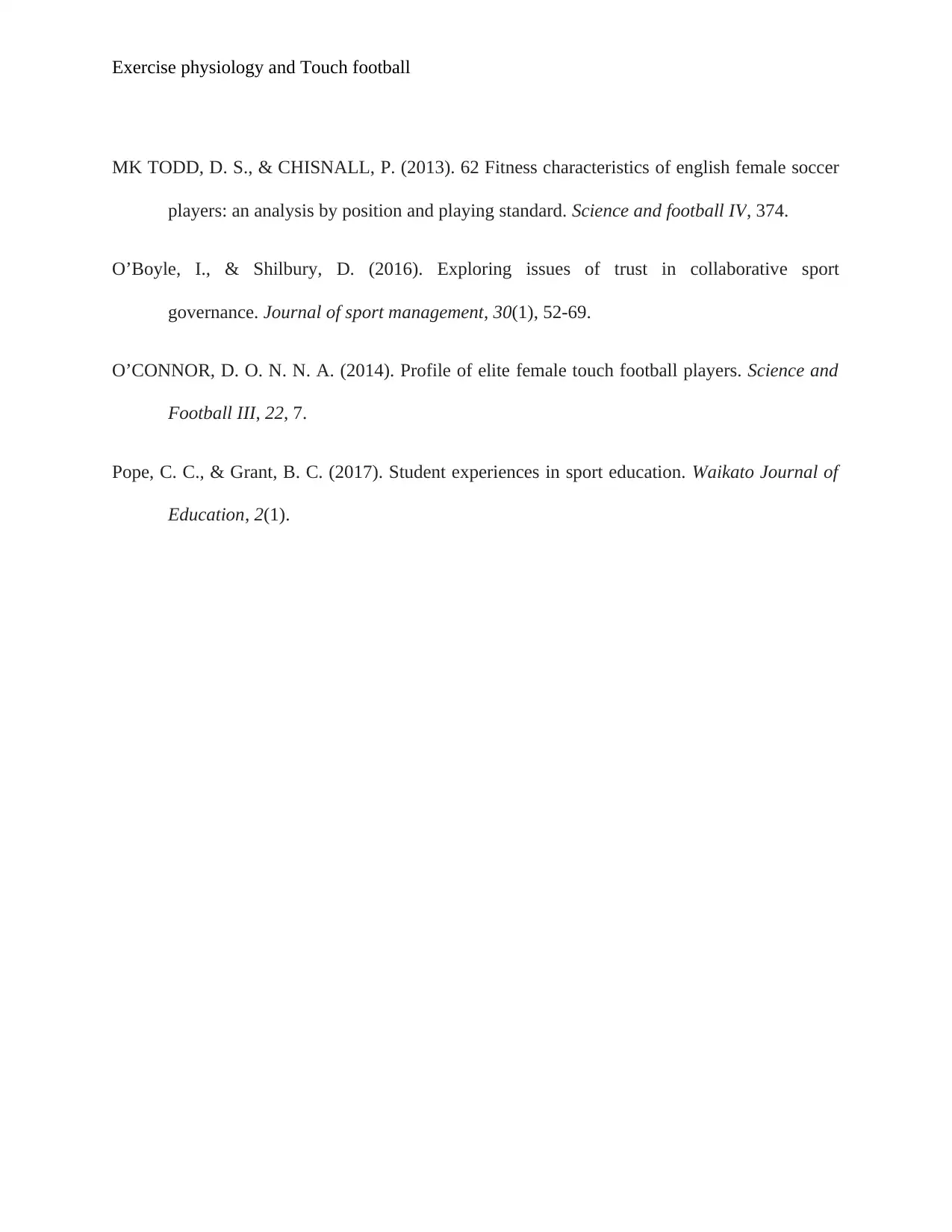
Exercise physiology and Touch football
MK TODD, D. S., & CHISNALL, P. (2013). 62 Fitness characteristics of english female soccer
players: an analysis by position and playing standard. Science and football IV, 374.
O’Boyle, I., & Shilbury, D. (2016). Exploring issues of trust in collaborative sport
governance. Journal of sport management, 30(1), 52-69.
O’CONNOR, D. O. N. N. A. (2014). Profile of elite female touch football players. Science and
Football III, 22, 7.
Pope, C. C., & Grant, B. C. (2017). Student experiences in sport education. Waikato Journal of
Education, 2(1).
MK TODD, D. S., & CHISNALL, P. (2013). 62 Fitness characteristics of english female soccer
players: an analysis by position and playing standard. Science and football IV, 374.
O’Boyle, I., & Shilbury, D. (2016). Exploring issues of trust in collaborative sport
governance. Journal of sport management, 30(1), 52-69.
O’CONNOR, D. O. N. N. A. (2014). Profile of elite female touch football players. Science and
Football III, 22, 7.
Pope, C. C., & Grant, B. C. (2017). Student experiences in sport education. Waikato Journal of
Education, 2(1).
1 out of 12
![[object Object]](/_next/static/media/star-bottom.7253800d.svg)





